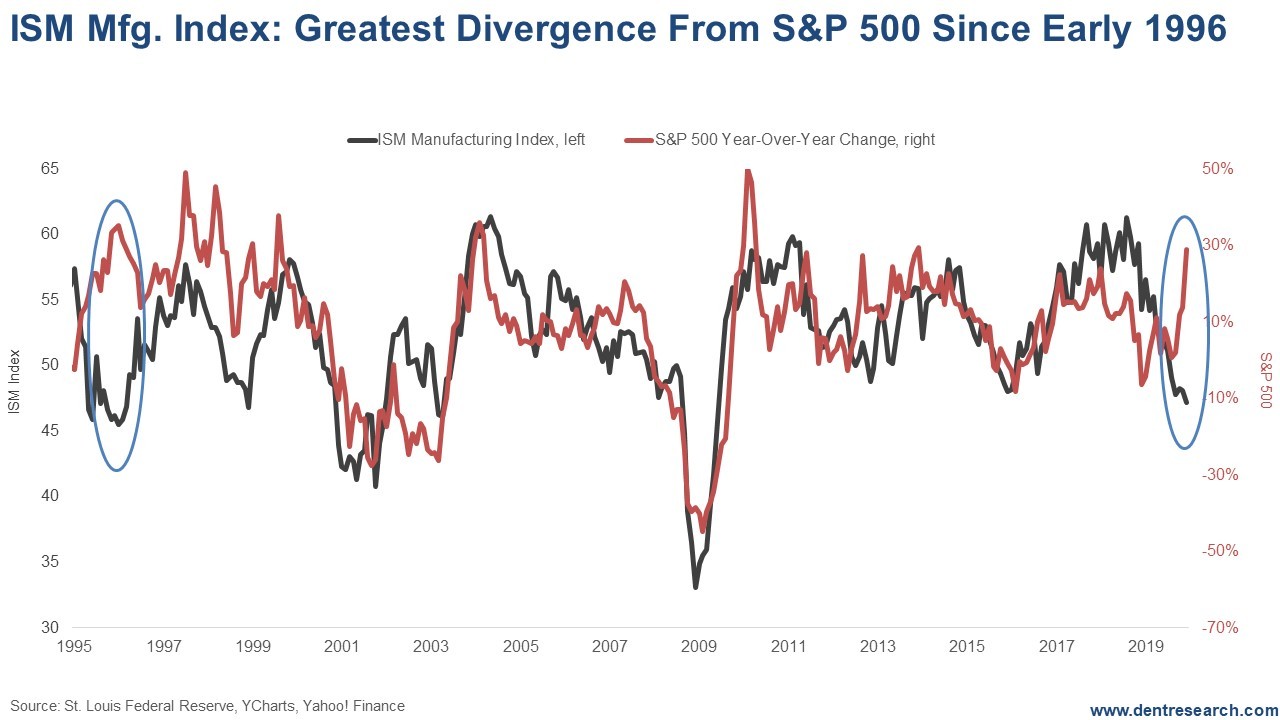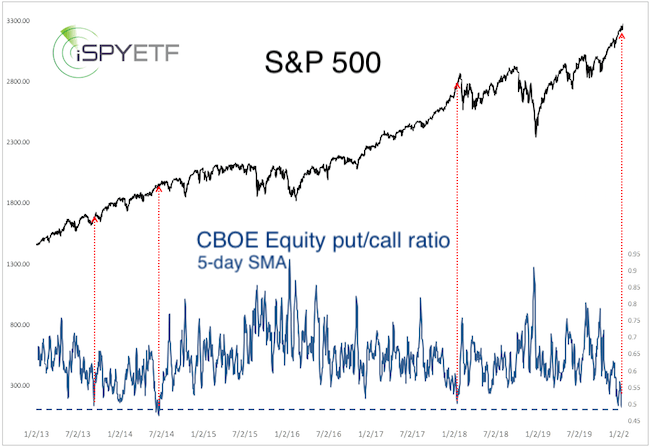Here’s an interesting divergence. Just as stocks head straight up since early October into what looks like the final blow-off phase of this bubble, 97% of corporate CFOs see a recession starting by the end of 2020.
Tons of Silicon Valley start-ups are looking to go public this year to beat a recession expected by 2021. That’s perfect to occur into a tech bubble top as into 2000.
This rally since the biggest correction since 2009 into December 2018, is tracking with the blow-off rally from 1998 into 2020 to peak around late May at as high as 11,000 Nasdaq. I’ll have more on that on Wednesday…
But here’s another divergence. The ISM Manufacturing index is a good leading indicator, and it is pointing down 10% while the S&P 500 has surged 30% recently. Here’s the chart…
This is the biggest divergence since early 1996, at the early stage of the first tech bubble. The other similar divergence was in late 1989/early 1990, before 1990’s 20% crash, the largest between 1987 and 2000.
Why? The largest monetary injections by the Fed, as I covered last Wednesday. By the way, we had some erroneous data from a Wall Street Journal article, and the cumulative “repo madness” money printing since September has been $425 billion instead of $505. But plans are still to print $80 billion a month ahead in normal QE, plus repos as needed, which means likely $110-$140 billion a month vs. $60 billion at peak QE in the past.
The put/call ratio at 0.45 is the most extreme since January 2018, just before that bubble-like peak, so stocks are short-term overbought. So, we could see some sort of correction any day…
But stocks just keep melting up with record flows of funny money into the financial asset pool on Wall Street. Forget the excuses that “this is just a temporary repo imbalance.” This is a full-out, even more aggressive form of QE. Any money injected into the financial asset arena – repos, T-bills, bonds, etc. – ends up with more money chasing the same assets and always migrates most to the highest gains from stocks, creating financial asset bubbles – period!
Repo madness, IPO madness, bad news doesn’t matter… This is all a clear sign of the final mania phase of this bubble, which started in early 2009 and is now the longest and most globally pervasive in history.
Best projection at this time: stocks continue up strongly into mid-year, then the volatility starts when economic slowing becomes more obvious than it already is now to corporate CFOs.
The content of our articles is based on what we’ve learned as financial journalists. We do not offer personalized investment advice: you should not base investment decisions solely on what you read here. It’s your money and your responsibility. Our track record is based on hypothetical results and may not reflect the same results as actual trades. Likewise, past performance is no guarantee of future returns. Certain investments such as futures, options, and currency trading carry large potential rewards but also large potential risk. Don’t trade in these markets with money you can’t afford to lose. Delray Publishing LLC expressly forbids its writers from having a financial interest in their own securities or commodities recommendations to readers.
Recommended Content
Editors’ Picks
EUR/USD edges lower toward 1.0700 post-US PCE

EUR/USD stays under modest bearish pressure but manages to hold above 1.0700 in the American session on Friday. The US Dollar (USD) gathers strength against its rivals after the stronger-than-forecast PCE inflation data, not allowing the pair to gain traction.
GBP/USD retreats to 1.2500 on renewed USD strength

GBP/USD lost its traction and turned negative on the day near 1.2500. Following the stronger-than-expected PCE inflation readings from the US, the USD stays resilient and makes it difficult for the pair to gather recovery momentum.
Gold struggles to hold above $2,350 following US inflation

Gold turned south and declined toward $2,340, erasing a large portion of its daily gains, as the USD benefited from PCE inflation data. The benchmark 10-year US yield, however, stays in negative territory and helps XAU/USD limit its losses.
Bitcoin Weekly Forecast: BTC’s next breakout could propel it to $80,000 Premium

Bitcoin’s recent price consolidation could be nearing its end as technical indicators and on-chain metrics suggest a potential upward breakout. However, this move would not be straightforward and could punish impatient investors.
Week ahead – Hawkish risk as Fed and NFP on tap, Eurozone data eyed too

Fed meets on Wednesday as US inflation stays elevated. Will Friday’s jobs report bring relief or more angst for the markets? Eurozone flash GDP and CPI numbers in focus for the Euro.

